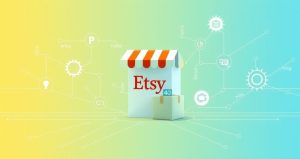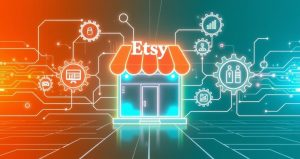Running a successful Etsy shop involves much more than creating beautiful products. It requires managing inventory, marketing, shipping, and finances. As your business grows, these tasks can become overwhelming. This is where Etsy integrations become essential. By connecting your Etsy store with other specialized software and platforms, you can automate repetitive tasks, streamline your workflow, and free up valuable time to focus on what you do best: creating. These tools act as a digital team, working behind the scenes to ensure your operations run smoothly and efficiently.
What Are Etsy Integrations?
Etsy integrations are software connections that allow your Etsy shop to communicate directly with other applications. Think of them as bridges that transfer data automatically between platforms. For example, when you make a sale, an integration can send the order details to your shipping software or update your accounting ledger without any manual input. This automation minimizes human error, improves accuracy, and provides a seamless operational flow for your business. Utilizing the right Etsy integrations is a key strategy for scaling your creative venture into a professional enterprise.
Key Types of Etsy Integrations for Sellers
Choosing the right tools depends entirely on your business needs and biggest challenges. From managing logistics to amplifying your marketing efforts, there is an integration designed to help. Below are the most critical categories of Etsy integrations that successful sellers use to optimize their stores, enhance customer experience, and drive growth. Understanding these options is the first step toward building a more efficient and profitable online business.
1. Shipping and Fulfillment Integrations
Managing shipping is one of the most time-consuming tasks for any Etsy seller. Shipping integrations connect your shop to postal services and couriers, allowing you to purchase and print shipping labels in bulk. These platforms automatically import order details, eliminating the need to copy and paste addresses. Many offer discounted postage rates, saving you money on every order. Once an item is shipped, the integration sends tracking information back to Etsy, automatically notifying the customer and marking the order as complete.
2. Accounting and Bookkeeping Software
Keeping your finances in order is crucial for understanding your profitability and preparing for taxes. Accounting integrations, such as those for QuickBooks or Xero, automatically sync your sales data, fees, and expenses. This provides a real-time overview of your financial health without tedious manual data entry. These tools can categorize your transactions, track sales tax, and generate profit and loss statements, giving you the insights needed to make informed business decisions and simplify your tax preparation process significantly.
3. Marketing and Social Media Automation
Promoting your products is essential for attracting new customers. Marketing integrations help you automate your social media and email campaigns. You can connect your Etsy shop to platforms like Pinterest, Instagram, or Mailchimp to schedule posts featuring your listings. Some tools automatically create promotional graphics or share new products as soon as they are listed. Email marketing integrations allow you to build a customer list and send newsletters, promotions, and updates, fostering customer loyalty and encouraging repeat purchases with minimal effort.
4. Inventory and Order Management
For sellers who operate on multiple channels, such as Etsy and a personal Shopify website, managing inventory is a major challenge. Inventory management integrations sync your stock levels across all platforms in real time. When an item sells on one channel, the inventory count is automatically updated on the others, preventing you from overselling out-of-stock products. This multi-channel synchronization is vital for maintaining a professional reputation and providing a positive customer experience across your entire online presence.
5. Print-on-Demand (POD) Services
Print-on-Demand has become a popular business model for artists and designers. POD integrations connect your Etsy store with a production partner like Printful or Printify. When a customer purchases a design on a product like a t-shirt or mug, the order is automatically sent to your POD partner. They then print, package, and ship the item directly to the customer under your brand. This model eliminates the need to hold physical inventory, manage production, or handle shipping yourself.
6. Customer Relationship Management (CRM)
As your customer base grows, providing personalized service becomes more difficult. A CRM integration helps you manage customer communications and data more effectively. These tools centralize conversations, track purchase history, and allow you to segment your audience for targeted marketing. By having a complete view of each customer’s journey, you can offer better support, identify your most loyal buyers, and build stronger, lasting relationships that encourage repeat business and positive reviews. This is a powerful tool for elevating your customer service.
How to Choose the Right Etsy Integration
Selecting the best Etsy integration requires a clear understanding of your business’s primary needs. Start by identifying your biggest bottleneck. Is it the time you spend packaging orders, reconciling finances, or promoting your listings on social media? Once you know the problem, you can look for a solution. Consider the cost of the tool; many offer free tiers or trials, while others have a monthly subscription fee. Evaluate the ease of use and check reviews from other Etsy sellers to ensure the platform is reliable and well-supported.
It is also important to consider scalability. Choose an Etsy integration that can grow with your business. A tool that works for 10 orders a month should also be able to handle 100 or more. Look for features that you may need in the future, even if you do not use them right away. A strategic choice today can save you from a complicated migration process down the line. The right integration should feel like a natural extension of your workflow, simplifying processes rather than adding complexity.
The Strategic Value of Etsy Integrations
Ultimately, Etsy integrations are more than just convenient tools; they are strategic assets for your business. By automating the administrative and logistical aspects of your shop, you unlock the time and mental energy needed for creative work and strategic planning. These connections reduce costly errors, provide valuable data for decision-making, and create a more professional experience for your customers. Investing in the right set of Etsy integrations is an investment in the long-term health and scalability of your creative enterprise, allowing you to work smarter, not harder.






